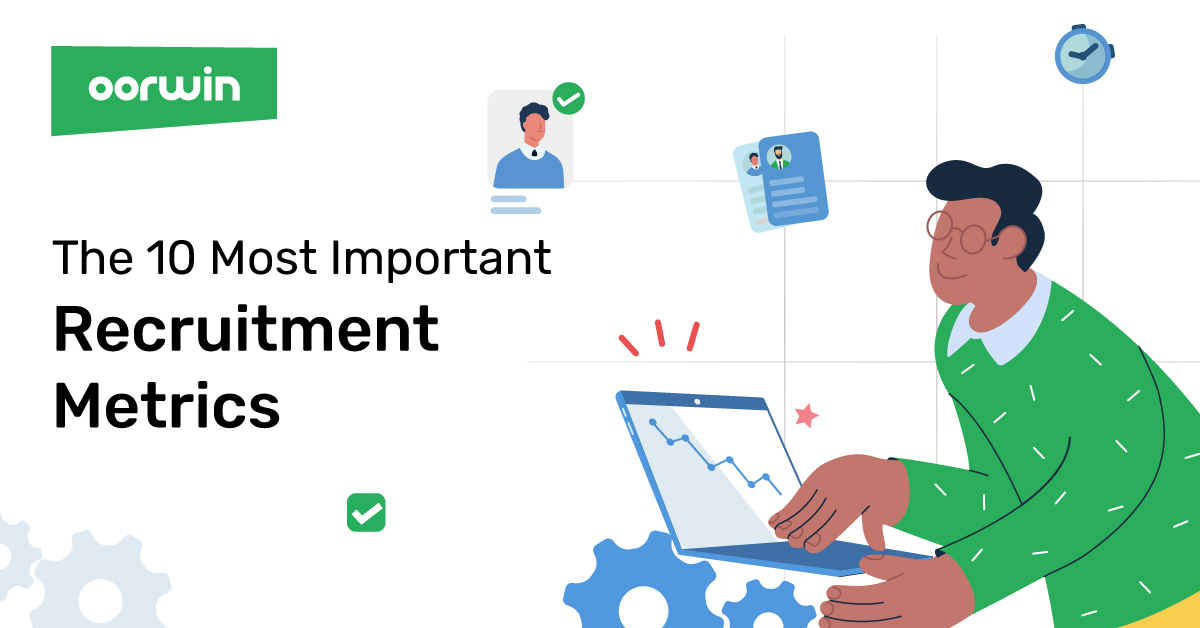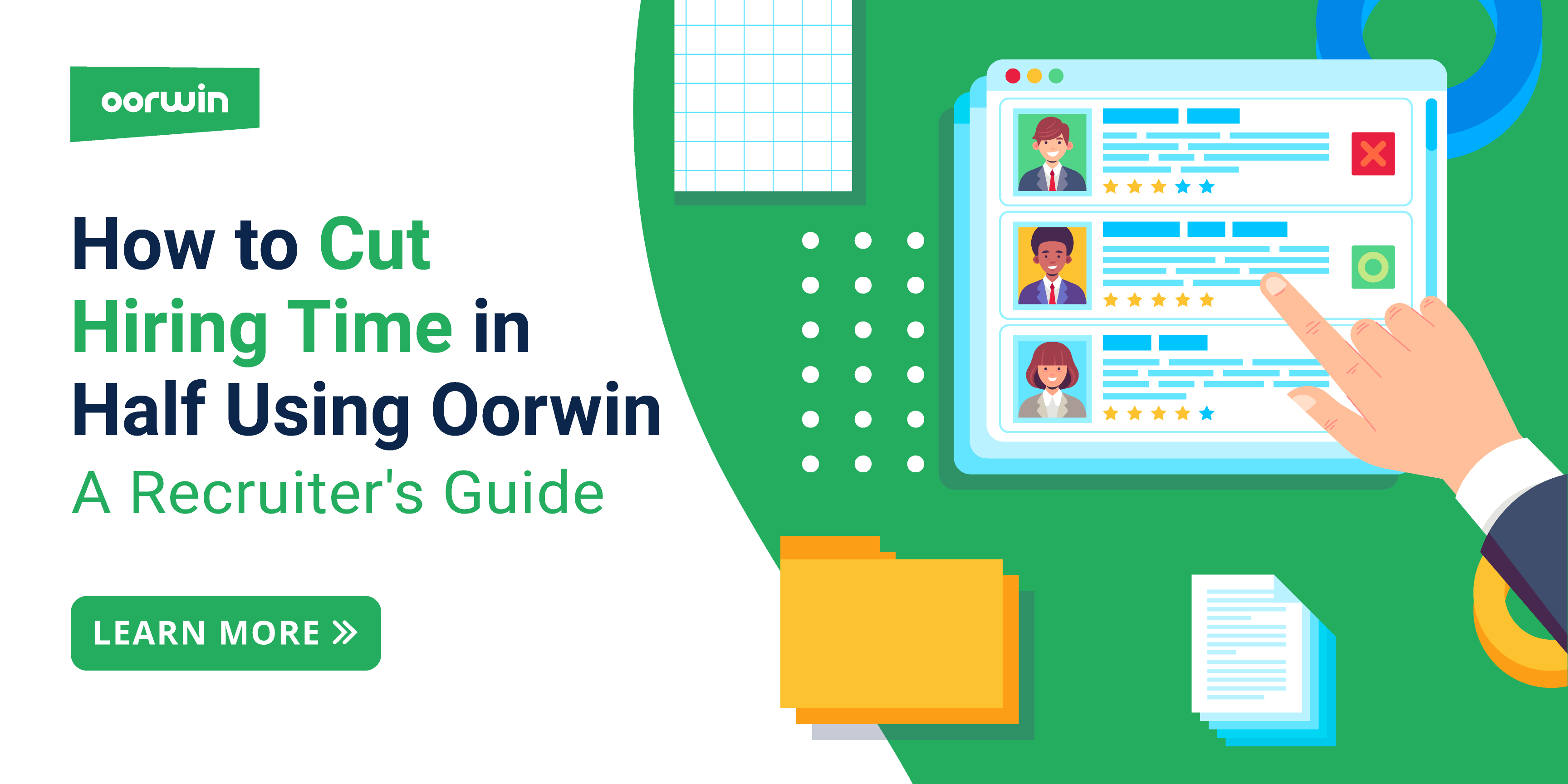20 Key Recruitment Metrics To Track In 2024
Oorwin
3min read / 18 Aug 2022

Related Articles
The 20 Most Important Recruitment Metrics To Track In 2024
In today’s competitive job market, recruiting and retaining top talent is more important than ever, but recruiters have faced serious challenges with the looming recession, talent shortage, high recruitment costs, and insufficient recruitment processes.
Recruitment or hiring metrics play a vital role in the continuous improvement of your hiring functions and measure success with razor-sharp accuracy. They are a set of measurements that track and evaluate hiring metrics for success and optimize your recruitment process using information-driven insights to guide you.
Leveraging data from talent analytics and recruitment reports helps you stay ahead of the competition by quickly seeing what needs improvement and where to focus your efforts.
What are Recruitment Metrics?
Recruitment Metrics help organizations track, analyze, and streamline the hiring process.
They are a crucial component of a recruitment funnel that is data-driven. Metrics for recruiting are essential for determining which functions need to be improved and where changes should be made because they show which processes are operating well and which are not.
Why Should You Track Recruitment Metrics?
Recruitment metrics give you the visibility you need to make informed, data-driven strategic decisions. The data provided can show valuable insights about your recruitment team and process so you can use your resources more effectively and increase your ROI.
These recruitment metrics allow you to measure the success of your hiring goals, track progress on internal recruiting benchmarks, and see how you compare with the market.
Top 20 Frequently used Recruitment Metrics to track in 2024
The sheer volume of recruitment metrics makes data-driven recruitment seem overwhelming. We’ve put together a list of the key hiring metrics you should track to get you started.
1. Time to Fill
Time to fill refers to the days between approval of a job requisition and acceptance of the job offer. It measures the speed and efficiency of your recruitment process.
You can use this recruitment metric to optimize your talent strategy. By monitoring time to fill, you gain a better understanding of the time it takes to fill or replace a position and identify which factors cause delays (such as industry and type of position).
2. Time to Hire
Time to hire refers to the days between a candidate applying for the position and accepting the job offer. This recruitment metric measures how fast each step of your recruitment process moves, zeroing in on bottlenecks and inefficiencies that create slowdowns.
3. Source of Hire
Monitoring the origin of new hires is crucial for evaluating the success of various recruitment channels, such as job boards, social media, and internal job listings. By identifying the most fruitful sources, organizations can strategically allocate resources to the most effective channels, enhancing ROI and streamlining the recruitment process. For instance, if data reveals that the company’s own job board outperforms LinkedIn in attracting qualified candidates, efforts and investments can be redirected accordingly to maximize efficiency.
4. Application Completion Rate
The application completion rate refers to the number of candidates who completed the job application process versus those who started but didn’t finish it. A low application completion rate can signal process issues. This allows you to see where to streamline processes to provide a better candidate experience and not miss out on top talent.

5. Offer Acceptance Rate
The offer acceptance rate is the difference between the number of candidates given a job offer and the number that accepts it.
A low rate is typically a sign of a lackluster employee value proposition for things like compensation and benefits. These insights can help you fine-tune your offering to be competitive with the talent market and create more transparent job postings.
6. Probation Rate
Quality of hire is measured by how quickly a candidate adjusts to their role and how well their performance is rated within their first year.
This hiring metric indicates whether you’re hiring the right people, which helps you cut costs associated with bad hires.
7. First-Year Attrition Rate
This measures the percentage of new hires who leave the company within their first year of employment. A high rate may indicate mismatches between job expectations and reality, deficiencies in the onboarding process, or broader issues within the company culture. Tracking this metric helps organizations identify and address the root causes of early turnover, improve retention strategies, and ensure a better fit between new hires and their roles.
8. Interview to Hire Ratio
With the interview-to-hire metric, the Quality of Hire may also be measured. This recruitment metric determines the percentage of applicants the recruiting function submits who are hired.
Ratios of interviews to hires indicate the strength of the shortlisting process. To maintain overall hiring effectiveness, ensure your organization has a solid interview-to-hire ratio.

9. Cost Per Hire
Cost per hire refers to the internal and external spending that make up the cost of hiring a candidate. Internal costs can include referral fees, admin costs, and training expenses. External costs can include background checks, marketing fees, and sourcing expenses.
This hiring metric adds value to your recruitment strategy by helping you drill down the specific costs for each step in your process. Allowing you to make data-driven decisions to fine-tune factors that unnecessarily drive up your cost per hire.
10. Number of Open Positions
This refers to how many open positions you have at any given time and how long they remain open on average.
A large percentage of open positions indicate high demand and rapid growth. But this recruitment metric could also indicate a low candidate supply and/or lack of demand or interest in the role.
11. Applications Per Open Role
The number of applications per open role is the total number of candidates that submit an application for a role.
A lot of applicants can signal high demand and interest in a position. But, depending on how many are qualified, it can also indicate an overly broad job description.
Minimal applications may indicate low demand or interest due to a poorly written job description or lackluster offering.
This recruitment metric is a great way for HR leaders to see the level of exposure their recruiters are able to achieve for their job postings.
12. Hiring Manager Satisfaction
Assesses the contentment of hiring managers with the recruitment process and the quality of hires through surveys or feedback forms. This metric reflects the recruitment team’s ability to understand departmental needs and provide candidates who meet or exceed expectations. High satisfaction scores suggest effective collaboration and communication between recruiters and hiring managers, whereas low scores may signal areas for process improvement.
13. Diversity Hiring Rate
This rate calculates the proportion of hires from diverse backgrounds, assessing the effectiveness of diversity and inclusion strategies in recruitment. It highlights the organization’s commitment to building a workforce that reflects a broad spectrum of human experiences and perspectives. Tracking this rate helps ensure equitable recruitment practices reach a wide range of talent pools, contributing to a more inclusive workplace.
14. Recruitment Funnel Effectiveness
Analyzes the conversion rate at each stage of the recruitment process, from initial application to final hire. By identifying drop-off points, companies can pinpoint areas where candidates lose interest or encounter barriers. This metric is vital for optimizing the recruitment funnel, enhancing candidate engagement, and ensuring a smooth hiring process.
15. Employee Referral Rate
The percentage of hires made through employee referrals. A high referral rate can indicate a positive internal culture where employees feel confident recommending the organization to their network. It often leads to quicker hires of higher quality due to the pre-existing trust and the vetting done by current employees.
16. Onboarding Effectiveness
Measures the success of the onboarding process through new hire satisfaction, speed to productivity, and initial performance indicators. Effective onboarding is crucial for employee retention, engagement, and productivity. This metric helps organizations refine their onboarding practices, ensuring new employees are well-integrated and able to contribute quickly.
17. Recruitment Marketing ROI
This hiring metric determines the return on investment of various recruitment marketing strategies, including social media, job fairs, and employer branding initiatives. By comparing the cost of these activities to the quality and quantity of candidates they attract, organizations can allocate their recruitment marketing budget more efficiently, focusing on high-ROI strategies.
18. Internal Mobility Rate
Tracks the movement of employees to new roles within the organization. A high internal mobility rate indicates a dynamic work environment where employees have opportunities for growth and development. It reflects the effectiveness of talent development strategies and the organization’s ability to retain talent by providing career progression opportunities.
19. Candidate experience
Consider the candidate’s experience while discussing recruiting metrics. A candidate experience survey is frequently used to gauge candidate experience, which is how job searchers view an employer’s hiring and onboarding procedure. The essential elements of the experience that can be improved are identified using the Net Promoter Score in this survey.
Remember that at various points of the hiring process, you may gauge the candidate’s experience. Refrain from discounting failed applicants, too. To gain a more true impression of your applicant’s experience, you should compare them to the ones you ultimately hired.
20. Candidate Net Promoter Score (NPS)
This measures the candidates’ willingness to recommend the company as a place to work based on their recruitment experience. This metric provides insights into the overall perception of the hiring process, from application through to rejection or hire. A high NPS suggests a positive candidate experience, which can enhance the employer’s brand and attract top talent.
Using a Talent Intelligence Platform to Track Recruitment Metrics
Talent Intelligence platforms like Oorwin make tracking recruitment metrics easy. They enable you to analyze large sets of data patterns in a comprehensive way using advanced visualization solutions and dashboards.
AI-enabled functions like predictive analytics can even help you predict factors like:
- The probability of job closure based on market factors
- Salaries using internal and external market trends
- Current versus potential workforce productivity
Data-driven recruiting helps you work smarter to hire and retain the best candidates using powerful insights and resources.

Learn more about how recruitment reporting can give you an edge over the competition by requesting a demo from Oorwin today.
FAQS
Why are recruitment metrics important in 2024?
Tracking recruitment metrics is vital for navigating challenges like talent shortages and high recruitment costs. These metrics enable organizations to make data-driven decisions, improving hiring efficiency and ROI.
What distinguishes Time to Fill from Time to Hire?
Time to Fill measures the duration from job requisition approval to offer acceptance, indicating overall recruitment speed. Time to Hire tracks the time from candidate application to job offer acceptance, pinpointing process efficiency.
How does tracking the Candidate Experience metric benefit recruitment?
Evaluating Candidate Experience through surveys helps identify and enhance aspects of the hiring process, ensuring a positive perception of the employer and improving the quality of hires by attracting top talent.
Popular Articles..
Blog

6min read / 25-Jun-2025
Master Effective Interview Techniques with Oorwin: A Step-by-Step Recruiter’s Guide
Blog
Blog
Get the latest Oorwin releases, updates, success stories & industry news
 Back
Back
